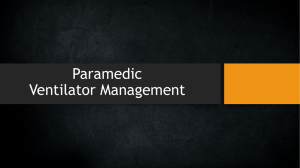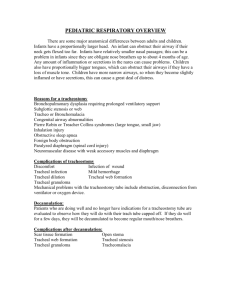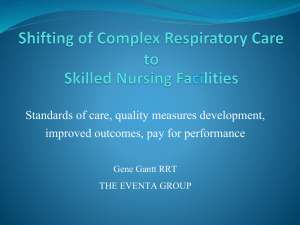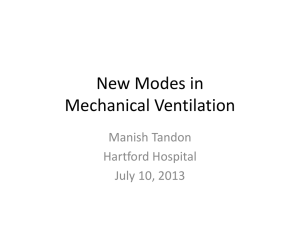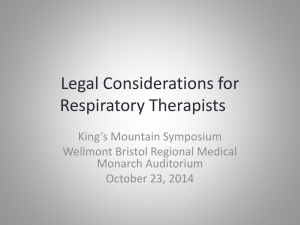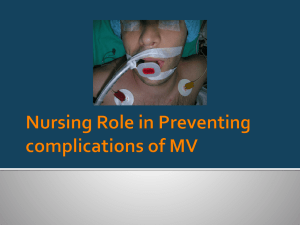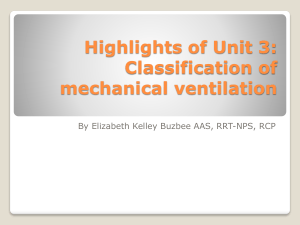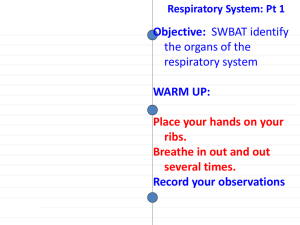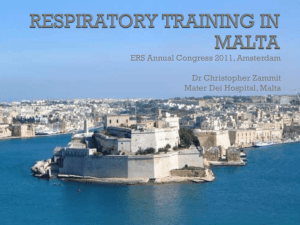Ventilator Auto-Triggering and Brain Death
advertisement
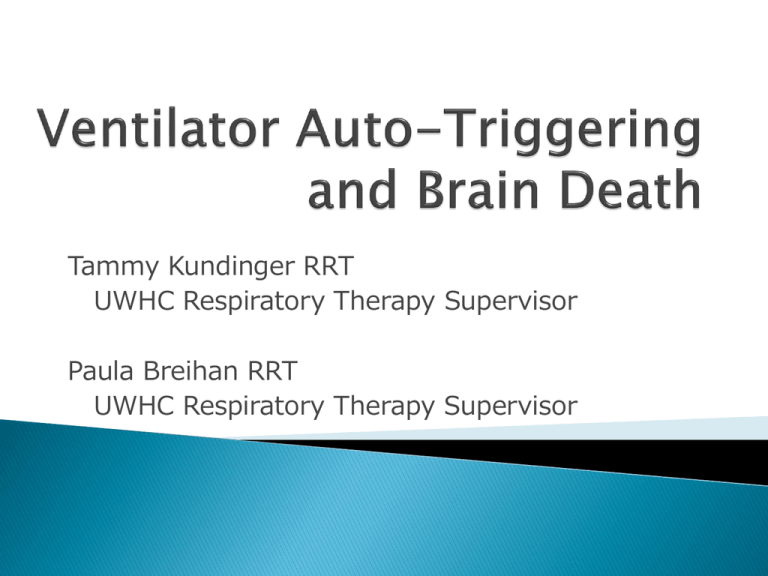
Tammy Kundinger RRT UWHC Respiratory Therapy Supervisor Paula Breihan RRT UWHC Respiratory Therapy Supervisor Identify how impaired brainstem function alters respiratory drive Identify causes of auto triggering with mechanical ventilators Understand recommendations to eliminate autotriggering The act reads as follows: “An individual who has sustained either 1) Irreversible cessation of circulatory and respiratory functions, or 2) Irreversible cessation of all functions of the entire brain, including the brain stem, is dead.” *It serves as a connector between the brain and other organs of our body. *It’s made up of three parts: midbrain, medulla oblongata and pons. The movement of eye muscles The movement of voluntary muscles The respiratory muscles It also… ◦Regulates autonomic functions and awareness ◦Regulates body temperature Respiratory Center ◦Controls the movement of respiratory muscles ◦Regulates the rate of respiration Vasomotor Center ◦Regulates blood pressure Reflex Center ◦Regulates reflex actions like sneezing, coughing, swallowing, etc Regulates sleep patterns Controls arousal functions like waking up or being alert Ø Ø Ø Ø Establish irreversible and proximate cause of coma Achieve normal core temperature Achieve normal systolic blood pressure (> 100 mmHg) Perform one neurologic exam *Usually several hours after brain insult *Some state statutes require 2 examinations These three parameters are necessary to confirm irreversible functions of the brain: Coma Absence of brainstem reflexes Apnea Ø Coma: Patients must lack all evidence of responsiveness Ø Absence of brainstem reflexes: § No pupillary response § No ocular movements § No corneal reflex § No facial muscle movements § No pharyngeal and tracheal reflexes Positive Apnea Test ◦Respiratory movements are absent ◦Arterial PCO2 is > 60 mmHg (or 20 mmHg increase in arterial PCO2 over baseline) Inconclusive Apnea Test ◦No appropriate rise in PCO2 over the baseline ◦If the patient is hemodynamically stable during the procedure the test may be repeated for a longer period of time (10-15 minutes) 1. Obtain baseline ABG and normalize PaCO2 (34-45mmHg) prior to testing 2. Preoxygenate for at least 10 minutes with 100% oxygen. 3. Disconnect patient from the ventilator 4. Preserve oxygenation by inserting a catheter into the endotracheal tube delivering 6 l/min oxygen. 5. Monitor patient closely for respiratory movement for 8-10 minutes 6. If no respiratory drive is observed, repeat blood gas after approximately 8 minutes. EEG Cerebral Angiography Nuclear Scan Transcranial Doppler Prolonged ICU stay for patients’ families Confusion for family ◦Ventilator triggering may question the diagnosis of brain death ◦Cardiac autotriggering may raise false hope of recovery ◦May lead to increased ICU costs Longer ICU time may lead to losing potential transplantable organs ◦Formal brain death protocols may take as long as 6-24 hours What should you do if the neurologic assessment has been completed and the patient has met all criteria for brain death but it looks like ◦The patient has finger tremors? ◦The patient has toe/plantar flexions? ◦The patient has an intrinsic respiratory drive? Transient bilateral finger tremor ◦Potential simultaneous toe reflex Retained flexion stimulation (plantar flexion) ◦Occurs in more than 50% of patients The AAN attests that autotriggering (or ventilator self-cycling) occurs when a ventilator breath is triggered in the absence of effort by the patient. Extrinsic Causes Random artifact in the ventilator circuit Water condensation in the ventilator circuit Ventilator circuit leak Endotracheal tube cuff leak Excessive retraction of an inline suction catheter Intrinsic Causes Cardiogenic oscillations Bronchopleural fistula Chest tube leak Ventilator artifact? Condensation in ventilator circuit? Leak in ventilator circuit? ETT cuff leak? Misplaced inline suction catheter? Cardiogenic oscillations ◦Is it fixable? Bronchopleural fistulas ◦How can you correct? Optimize your ventilation pressures. Chest tube leak ◦Reposition chest tube, obtain CXR to determine position, redress chest tube site, and increase bias flow on ventilator End result…intrinsic factors may prove to be more difficult to correct or even identify. Physical changes associated with brain death include: *Hyperdynamic cardiovascular state *Altered vasomotor tone This may produce a hyperdynamic pericardium which can be mistaken for respiratory movement Hyperdynamic cardiovascular state Displace intrathoracic volume & lung tissue Causing cardiogenic oscillation beyond the set trigger sensitivity Triggering ventilator breaths in the absence of an intrinsic respiratory drive Fluctuations in ventilator airway pressure, flow and potentially volume waveforms in time with the cardiac cycle Cardiogenic oscillations may be seen in greater amplitude in patients with a more hyperdynamic cardiovascular system. 83 patients ◦4 patients occasionally triggered the ventilator Autotriggering was eliminated by the adjustment of ventilator trigger or by changing the trigger from flow to pressure. Pressure Triggered ◦ The patient’s inspiratory effort causes a drop in pressure within the breathing circuit Flow Triggered ◦ The ventilator detects a drop in flow through the patient circuit during exhalation Flow Triggered ◦ Between breaths, the flow coming out of the main flow control valve and the flow going through the exhalation valve are equal ◦ During the patient’s inspiratory effort, the flow through the exhalation valve falls below the flow from the output valve ◦ The difference between these two flows is Continuous the flow trigger variable flow through circuit: “Base flow” Normally, a ventilated patient would be set on flow triggered sensitivity Flow triggering is more sensitive than pressure triggering Flow triggering is designed to ease the patient’s work of breathing by requiring less inspiratory effort An appropriate neurologic assessment Working together and utilizing the expertise of the interdisciplinary team, the organ procurement process can be improved Early identification of potential ventilator autotriggering can – ◦Minimize ICU stay ◦Reduce costs of care ◦Decrease family stress ◦Facilitate recovery of transplantable organs UWHC Practice Implementations for Successful Organ Procurement End of Life Sustaining Measures Order Set Donation after Cardiac Death Order Set (DCD) Brain Dead Donor Order Set (BDD) These order sets have specific algorithms that RT uses as a guide for the type of end of life ventilator management that is indicated in each patient scenario. UWHC Respiratory Care Brain Dead Donor Ventilator Management Algorithm Example patient scenario of how the BDD lung protective algorithm helps guide the RT in their management of the ventilator and assessment of the patient in preparation for organ procurement. •12/5 at 1800 arrived in ED & then transferred to ICU •12/5 at 2220 apnea test ordered •12/6 at 0410 patient pronounced brain dead •12/6 at 0432 BDD order set initiated •12/6 at 0916 bronchoscopy ordered •12/6 at 2001 oxygen challenge ordered •12/7 at 0140 patient taken to OR for organ donation In this example, the process took a very short amount of time from when the patient was admitted to actual OR time for organ procurement. Behind the scenes, this algorithm helps the process flow more smoothly and eliminates questions and reduces response time to new orders. Tammy Kundinger UWHC RT Supervisor – Neuro ICU tkundinger@uwhealth.org Paula Breihan UWHC RT Supervisor – TLC ICU pbreihan@uwhealth.org Araullo, M., Frank, J., & Goldenberg, F. (2007). Transient bilateral finger tremor after brain death. Neurology, 68, 22. Arbour, R. (2012). Confounding factors in brain death: Cardiogenic ventilator autotriggering and implications for organ transplantation. Intensive and Critical Care Nursing, 28(6), 321-328. Arbour, R. (2009). Cardiogenic Oscillation and Ventilator Autotriggering in Brain-Dead Patients: A Case Series. Am J Crit Care, 18, 496-488. doi:10.4037/ajcc2009690 De Wit, M. (2011). Monitoring of Patient-Ventilator Interaction at the Bedside. Respiratory Care, 56 (1), 61-72. Dodd-Sullivan, R., Quirin, J., & Newhart, J. (2011). Ventilator autotriggering: a caution in brain death diagnosis. Progress in Transplantation, 21(2), 152-155. Wijdicks, EFM, Varelas, P., Gronseth, G., & Greer, D. (2010). Evidence-based guideline update: Determining brain death in adults: Report of the Quality Standards Subcommittee of the American Academy of Neurology. Neurology, 74, 1911-1918. Widjicks, EFM, Manno, E., & Holets, S. (2005). Ventilator self-cycling may falsely suggest patient effort during brain death determination. Neurology, 65, 774. doi:10.1212/01.wnl.0000174626.94197.62 Zubkov, A. & Wijdicks, EFM. (2008). Plantar flexion and flexion synergy in brain death. Neurology, 70, 74.
